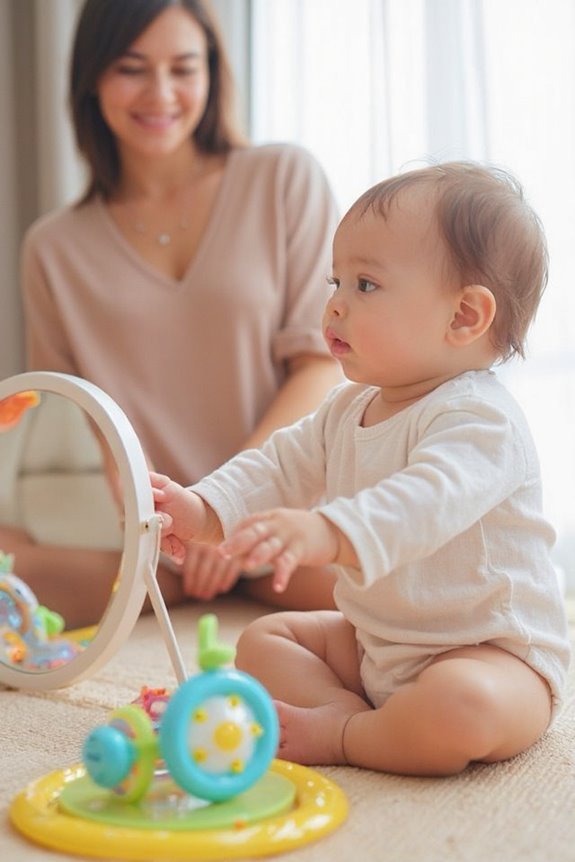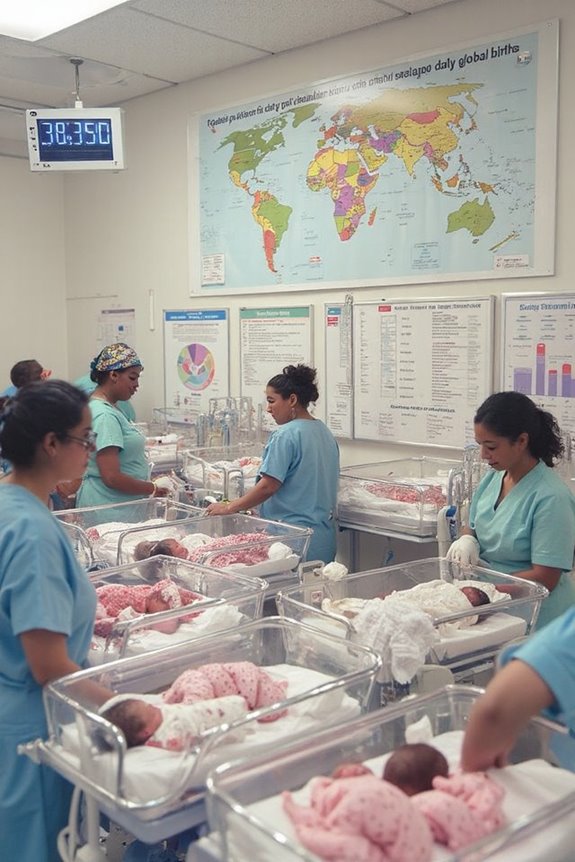In the U.S., approximately 3.6 million babies are born each year. The most recent data shows 3,622,673 births in 2024, a 1% increase from 2023. This reflects a general downward trend since the 2007 peak of 4.31 million births. The current fertility rate is about 1.786 births per woman, below replacement level. While women 15-24 are having fewer children, birth rates for women 25-44 have increased. These numbers reveal fascinating patterns about American family planning decisions.
Key Takeaways
- 3,622,673 babies were born in the United States in 2024, showing a 1% increase from 2023.
- U.S. birth numbers have declined from a peak of 4.31 million in 2007 to current levels.
- The current U.S. fertility rate is approximately 1.786 births per woman.
- First quarter of 2025 recorded about 869,000 births, suggesting continued stability.
- Birth rates are decreasing for females ages 15-24 but increasing for women ages 25-44.
Current Birth Statistics in the United States
Millions of babies enter the world each year in the United States, with recent data showing a slight uptick in birth numbers. In 2024, we saw 3,622,673 births—a 1% increase from 2023. This represents a small but notable shift in birth demographics after years of declining rates.
The first quarter of 2025 recorded approximately 869,000 births, suggesting this year’s numbers may remain relatively stable. Despite long-term downward trends, the U.S. fertility rate now sits at about 1.786 births per woman.
What does this mean for population growth? While birth rates are lower than historical averages, births still outnumber deaths in America. This natural increase continues to support modest population growth, though at a slower pace than previous decades.
Historical Trends in U.S. Birth Rates (2000-2024)
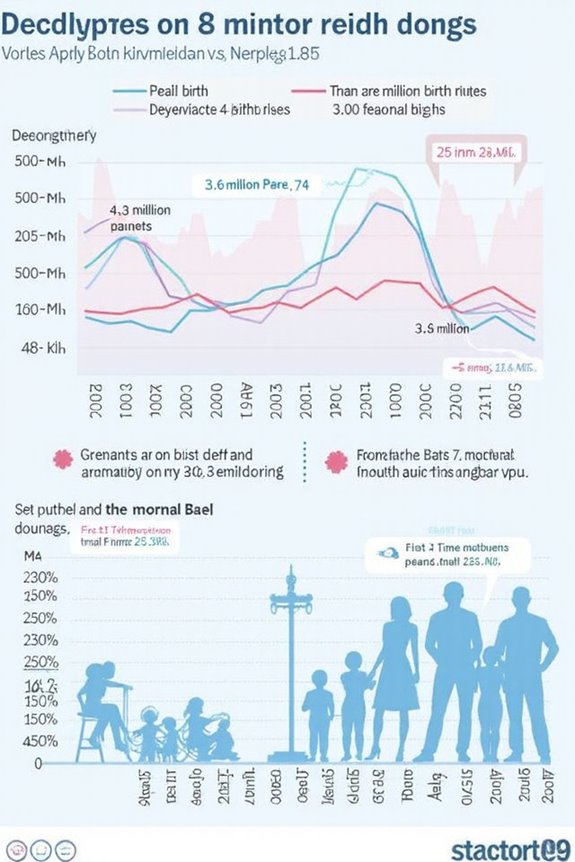
Since the turn of the millennium, America’s birth landscape has undergone significant changes, reflecting broader societal and economic shifts. Birth rate fluctuations have followed distinct patterns:
- 2000-2007: Birth numbers increased steadily, reaching peak years in 2007 with approximately 4.31 million births
- 2008-2019: Following the economic crisis, a consistent decline began
- 2020-2023: A slight increase occurred from 2020 to 2021, followed by stability in 2021-2022 (3.67 million births)
- 2023: Further decrease to 3.59 million births
These trends reflect America’s changing priorities and economic realities. The 2008 financial crisis marked a turning point, as economic uncertainty influenced family planning decisions. Since then, I’ve observed that education, career advancement, and financial stability increasingly factor into childbearing decisions.
Age-Related Patterns in American Fertility
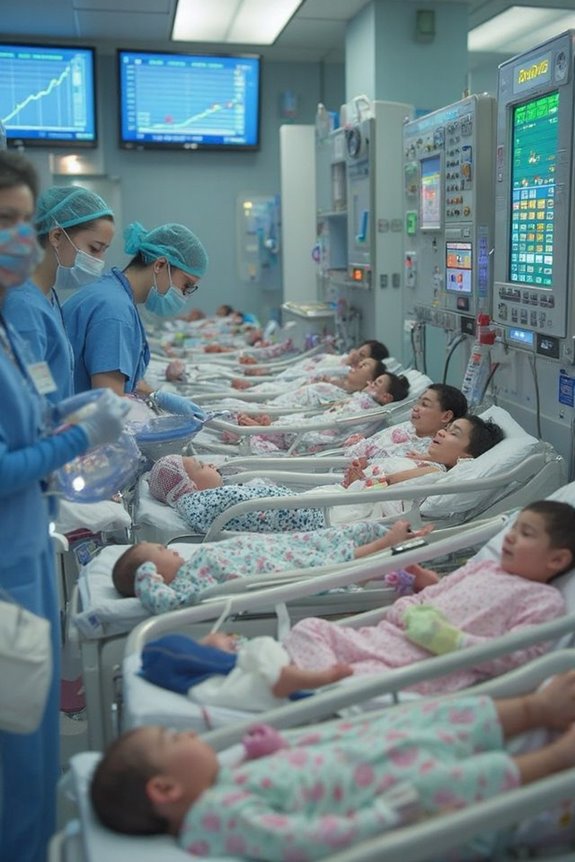
When examining U.S. birth trends, age-related patterns reveal a significant shift in when Americans choose to have children. Age-specific fertility data shows younger women are having fewer babies while older women are having more:
- Birth rates for females ages 15-24 decreased in 2024
- The teenage birth rate (ages 15-19) dropped by 3%
- Birth rates for women ages 25-44 increased
- Women ages 40-44 saw a 2% increase in birth rates
These changing demographics reflect broader societal shifts in career priorities and family planning decisions. The general fertility rate reached 54.6 births per 1,000 women aged 15-44 in 2024, a slight increase from the previous year. However, the total fertility rate is projected to decline to 1.60 births per woman by 2035, affecting future population growth.
Economic Influences on Family Planning Decisions
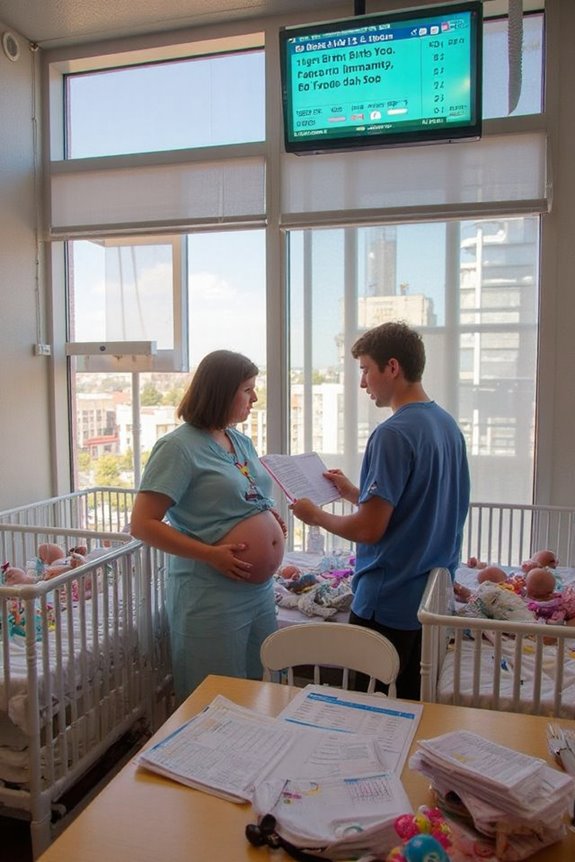
The financial landscape of American households greatly shapes decisions about having children and family size. I’ve observed that many couples delay starting families until they achieve financial security, as the reality of child rearing expenses continues to climb.
Several economic factors affect these decisions:
- Rising education costs, from daycare through college
- Housing affordability, particularly in urban areas where larger homes are increasingly out of reach
- Employment stability, with many families reluctant to expand during periods of job uncertainty
During economic downturns, birth rates typically decline as families postpone having children. The cost of living increase across healthcare, housing, and education creates a significant financial burden that often results in smaller family sizes, especially in areas with limited government support for families.
Maternal Health and Delivery Methods

Maternal health indicators across the U.S. have shown notable shifts in 2024, with birth numbers increasing by 1% to approximately 3.6 million deliveries nationwide. This uptick suggests improved access to prenatal care services, though disparities persist across racial and socioeconomic lines.
Regarding delivery methods, cesarean deliveries increased to 32.4% of all births, while the preterm birth rate remained steady at 10.41%. These statistics reflect important trends in maternal care protocols:
- Women ages 25-44 experienced higher birth rates than younger demographics
- Low-risk cesarean delivery rates held at 26.6%
- Advanced monitoring technologies have enhanced delivery safety
The relationship between maternal age and delivery outcomes remains significant, with older mothers often requiring specialized care to manage potential complications and guarantee positive health outcomes.
Future Demographic Projections Through 2035
As we look toward America’s demographic future, I’m seeing considerable shifts that’ll reshape our national landscape through 2035. Population projections indicate a substantial slowdown in growth rates – declining from 0.6% annually (2024-2034) to just 0.2% by the mid-2030s.
Key demographic shifts to anticipate:
- The U.S. population will increase from 331 million (2020) to approximately 349 million by 2030
- Total fertility rate is expected to remain near the historic low of 1.6 children per woman
- Deaths will exceed births by 2038, creating negative natural population change
- Immigration will become increasingly critical to offset declining birth rates
- An aging population will impact healthcare needs and the labor force
These changes will considerably influence economic growth and social service demands.
Frequently Asked Questions
How Do Immigration Policies Affect National Birth Statistics?
I’m absolutely blown away by how dramatically immigration trends shape our nation’s birth data. Immigration policies directly impact fertility rates, as foreign-born women typically have higher birth rates than native-born women, shifting our demographic landscape.
What Role Does Paternity Leave Play in Birth Rate Trends?
I’ve noticed paternity leave can reshape family dynamics by supporting parents during essential early stages. While direct impact on birth rates isn’t well-documented, it likely creates more supportive environments for family planning decisions.
How Do Birth Rates Vary by Education Level?
Like steps on a ladder, birth rates typically descend as education levels climb. I’ve noticed women with higher education often delay childbearing, while socioeconomic status influences family planning decisions across education impact categories.
What Impact Do Environmental Factors Have on Fertility Trends?
I’ve observed that environmental factors heavily impact fertility. Climate change disrupts reproductive hormones, while pollution effects can damage reproductive cells. These stressors increasingly challenge couples trying to conceive in today’s changing environment.
How Do Birth Rates Differ Across Urban Versus Rural Communities?
I’ve noticed that rural communities generally have higher birth rates than urban areas. Urban families often delay childbearing due to career pursuits, while rural healthcare limitations sometimes impact family planning access and reproductive services.



